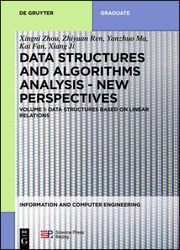 Название: Data Structures and Algorithms Analysis – New perspectives. Volume 1: Data Structures Based on Linear Relations
Название: Data Structures and Algorithms Analysis – New perspectives. Volume 1: Data Structures Based on Linear RelationsАвтор: Xingni Zhou, Zhiyuan Ren, Yanzhuo Ma
Издательство: De Gruyter
Серия: Information and Computer Engineering, 6
Год: 2020
Страниц: 308
Язык: английский
Формат: pdf (true), djvu
Размер: MB
Data structures is a key course for computer science and related majors. This book presents a variety of practical or engineering cases and derives abstract concepts from concrete problems. Besides basic concepts and analysis methods, it introduces basic data types such as sequential list, tree as well as graph. This book can be used as an undergraduate textbook, as a training textbook or a self-study textbook for engineers.
- Provides an up-to-date overview of data structures, covering both classical and recent results.
- Presents the advanced theories in an easy-to-understand way.
- Includes exercises, making it also suitable for self-study.
Before learning data structures, one should have foundational knowledge about program design. Let’s look at issues related to programming first. What is programming? Programming is not only about understanding of the grammar, but also involves the various aspects mentioned below:
1. The flow of thought for problem solving: algorithms are complete problem solving steps constituting basic computations and specified computational sequences. They are the soul of the program. The quality of the algorithms has a direct impact on the efficiency of the program. The conventions used by this book to describe algorithms are illustrated later.
2. The execution speed of the program: the execution speed of the program depends on a lot of factors. The user usually has requirements on the execution speed of the program, for example, real-time response systems.
3. The memory usage of the program: the execution of the code needs the corresponding memory space and runtime environment. In some occasions, there are limitations for the memory usage of the program, for example, embedded systems.
4. Coding standards: the code needs to be written according to certain standards to ensure the consistency of the code, for the purposes of communication and maintenance.
5. The structure of the program: a complex program consists of multiple relatively independent modules. High intramodule cohesion and low intermodule coupling is the standard to use on whether the program structure is reasonable.
6. Module interfaces: the communication between modules is done via interfaces. The parameters for passing information between modules should be reasonable and effective.
7. Testing and tuning of the program: use well-designed test cases to test whether the program is correct. Testing is an effective way to finish a software product with high efficiency. A proficient programmer is also a testing expert. The majority of experience and methods of testing are obtained via practice.
Скачать Data Structures and Algorithms Analysis – New perspectives. Volume 1: Data Structures Based on Linear Relations